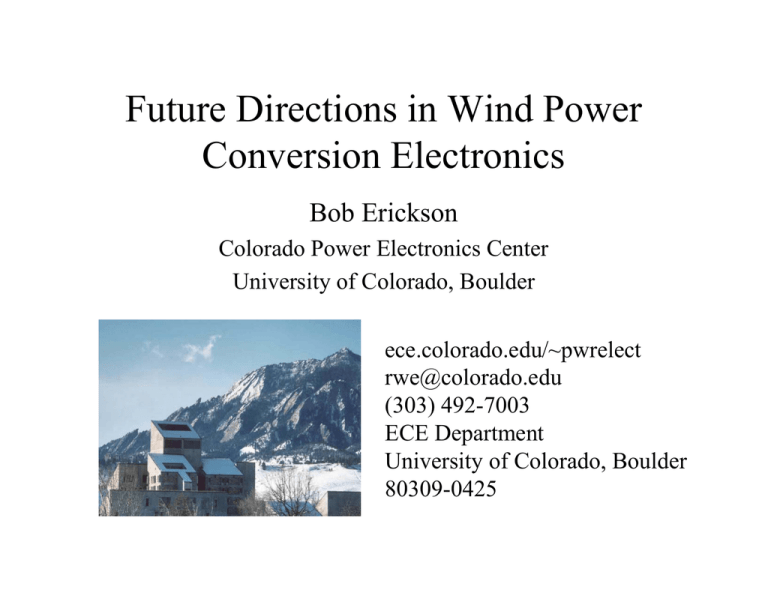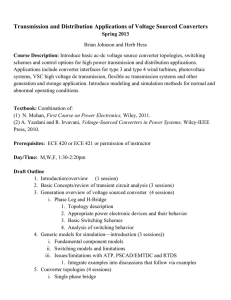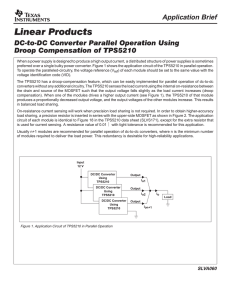Future Directions in Wind Power Conversion Electronics
advertisement

Future Directions in Wind Power Conversion Electronics Bob Erickson Colorado Power Electronics Center University of Colorado, Boulder ece.colorado.edu/~pwrelect rwe@colorado.edu (303) 492-7003 ECE Department University of Colorado, Boulder 80309-0425 Power Conversion in Variable-Speed Wind Power Systems Wind turbine Ac-ac converter Generator Critical issues: • Maintaining high efficiency over a wide range of voltages and wind speeds • Reduction of capital cost • Quality of electrical waveforms injected into utility and generator Variable-voltage variable-frequency three-phase ac AC power to utility 480 V three-phase 60 Hz Wind turbine Doubly-fed Generator Stator 480 V three-phase 60 Hz AC power to utility Rotor Variable-voltage variable-frequency three-phase ac Ac-ac converter About Power Electronics Technology • Evolution of magnetics and capacitor technology is slow • Evolution of microprocessor/microcontroller technology is rapid • Evolution of power semiconductor technology is rapid o Low voltage (< 1kV) power semiconductors are inexpensive and exhibit high performance o Progress in high voltage controlled devices such as HVIGBT’s • Major gains in packaging technology Conclusion— where to focus research thrusts: Use of silicon to make significant gains in converter performance, size, and/or cost • Use silicon to improve performance • Increased intelligence and complexity; finer structure • Improve efficiency, reduce capital cost, improve waveform quality, improve reliability Conventional converters are not optimized for variablespeed wind power applications • Poor efficiency in Region II reduces energy captured • A smaller converter could attain higher efficiency at low wind? Generator power or voltage Region I Region II Region III Speed Converter efficiency The Problem of Poor Converter Efficiency at Low Wind Speed • We showed that the origin of this problem is the reduction of converter efficiency that occurs when the generator voltage is reduced • Other mechanisms, such as circulating currents in resonant converters or in doubly-fed systems, can also contribute to this phenomenon 100% Typical efficiency vs. power throughput Two-level dc link system in wind power environment Inverter Rectifier Efficiency • Typically observed in variable-speed wind generator systems 95% Composite • Includes semiconductor conduction and switching losses 90% • PWM rectifier and inverter • Rectifier losses dominate at light load 85% 0% 20% 40% 60% P/Pmax 80% 100% Indirect Power in PWM Boost Rectifier Input of conventional DC link system reduces to boost rectifier: – vin (vout – vin) + – DTs Ts + + – iout + 4vin vout 3vin – When the converter is required to process substantial indirect power, efficiency is degraded. This mechanism explains the observed problems in variablespeed wind power applications vout 2vin Indirect power = iout (vout – vin) vin Direct power = ioutvin 0 0.2 0.4 0.6 Transistor duty cycle 0.8 1 Reconfigurable AC-DC converters + L DC output H L AC input – Single-phase PWM boost converter example Reconfigure converter to improve efficiency at low input voltage, while maintaining high output voltage Measured Efficiencies of Single-Phase PWM Boost Rectifiers Two-Level vs. Reconfigurable Three-Level PWM 0.96 Three level (doubler mode) Efficiency 0.94 Two level 0.92 0.9 • DC link voltage = 385 V • Constant power 0.88 0.86 80 100 120 140 160 180 200 AC input voltage (Vrms) 220 240 260 Multi-Level Switching Two-level switching t Three-level switching t 2-Level Converters 100% Improvement of Converter Efficiency via ThreeLevel Switching Inverter Rectifier 95% Composite 90% 85% 0% 20% 40% 60% 80% 100% 60% 80% 100% P/Pmax 3-Level Converters 100% Predicted by experimentallyverified model of semiconductor conduction and switching loss Inverter Rectifier Composite 95% 90% 85% 0% 20% 40% P/Pmax Discussion • Switching loss can be modeled by equations of the form Psw = (∆v) Q fsw • • • • Multilevel switching reduces the voltage step (∆v), and hence improves efficiency at full load Multilevel switching reduces the indirect power at low input voltage Efficiency at light load is improved, and the knee of the efficiency curve is shifted to the left Resonant conversion and/or soft switching techniques may be unnecessary How to realize multilevel switching? The Case for Small Module Size • Low-voltage IGBT’s have very low cost – Less than $1 in high volume for 600V 50A 100KHz IGBT: specific cost of $0.03/KVA – Higher voltage IGBT modules typically have specific costs of $0.50/KVA • Built by machine on printed circuit boards: low manufacturing cost • High quality utility and machine waveforms • Lower switching loss and better utilization of silicon • Improved efficiency at low wind speed A new family of ac-ac matrix converters capable of multilevel switching Basic converter Modular switch cell n b Three-phase ac system 1 a A Realization ic Three-phase ac system 2 c A B iA iB + – a ib – + N C iC Q1 D1 a Q3 + – ia – + + – – + Symbol D3 D2 A D4 Q2 Q4 At rated voltage: two-level operation At low voltage: three-level operation Advantages of Proposed Converters • Multilevel conversion is possible, even in the basic version. This enables improvement of the low-wind efficiency of the converter, without sacrificing performance at rated power • The converter can both step up and step down the voltage magnitude • Switch commutation is simple • Modular construction allows scaling to higher voltage and current levels, using inexpensive low-voltage silicon • Simple bus bar structures • High quality waveforms New Modular Multilevel Matrix Converter in a Wind Power Application Variable-voltage variable-frequency three-phase ac SAa SAa SAa Generator Wind turbine Proposed new matrix converter Switch cell: Q1 Converter contains a matrix of switch cell modules SBa SBa SBa SCa SCa SCa D1 a Q3 D3 D2 A D4 AC power to utility 60 Hz Q2 Q4 Variable-voltage variable-frequency three-phase ac Increasing the number of levels AC power to utility 60 Hz Generator Wind turbine Proposed new matrix converter Doubly-fed Generator Doubly fed system Stator AC power to utility 60 Hz Rotor Wind turbine Variable-voltage variable-frequency three-phase ac Proposed new matrix converter Experimental Data Utility-side AC voltage and current (60 Hz) Machine-side AC voltage and current (30 Hz) 60 Hz to 30 Hz Data Maintenance of DC capacitor voltage Upper trace: capacitor voltage of one switch module Lower trace: 60 Hz current injected into utility Controller Block Diagram Implemented in Verilog and downloaded into programmable logic arrays Issues: Multilevel Modular Converters • Complexity of control of individual module voltages and currents – Centralized control algorithm not feasible as number of modules is increased – Requires new decentralized control approaches • Topologies: interconnection of modules – Other modular topologies may allow better control – Effect on efficiency Conclusions • The variable-speed wind power application requires better ac-ac converters having – Lower capital cost – Improved efficiency over a wide range of wind speeds and generator voltages – Better terminal waveforms • Electronic power converters having finer structure are becoming feasible: – Inexpensive, high performance silicon switches – Sophisticated controllers – High level of packaging technology Conclusions Continued • Multilevel switching can address the issues of variable speed wind power – Reduced switching loss improves efficiency without need for resonant techniques – Improved efficiency over wide range of wind speeds – Improved waveform quality • New modular converter topologies – Allow scaling to higher powers and higher voltages – Could allow use of advances in packaging and lowvoltage silicon in megawatt applications – Need additional work in decentralized control and modular topologies






